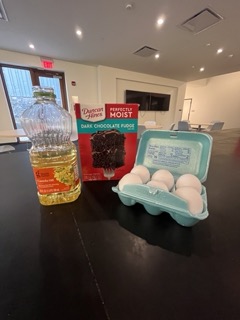
Cake is a delicious dessert and a celebration staple, and they can range from simple sheet cakes to complex replications of real-life items. With all the hype around cake, it seemed important to investigate the science behind cakes—and what takes the flavor of a cake to the next level. Nothing is simpler than a boxed chocolate cake mix, but we wanted to find a way to make it taste even better. Before we can understand how to amplify the flavor of chocolate cake, we need to understand the chemistry of making cakes.
For a basic cake, every ingredient is essential. Charlie Boss said, “Flour provides the structure; baking powder and baking soda give the cake its airiness; eggs bind the ingredients; butter and oil tenderize; sugar sweetens; and milk or water provides moisture.” All of the ingredients working together create the fluffy, sweet cake that we know and love. The leavening agents, flour, and sugar are premixed for boxed cake mixes, and all the baker must do is add the oil, water, and eggs.
When mixing a cake mix, the flour forms minimal gluten to give the cake a bouncy texture. This lowered gluten formation is essential because the desired consistency of cake is bouncy and airy, not dense. The eggs bind all the ingredients together. The water and oil help retain the moisture in the cake so that it does not dry out when baked. Each ingredient plays a role in making the cake turn out just right.
The chocolate in a chocolate cake is also just as important. Chocolate gets is classic flavor through an intense process. Sheryl Berringer discusses how Maillard Browning affects the flavor, saying the “sugar and protein” in the fermented cacao beans are “[brought] together under high heat, which causes the sugar and protein to react and form that wonderful aroma.” The cocoa powder is added to a chocolate cake which not only gives it a chocolate flavor, but it also, reacts to the baking soda to get the desired reaction of gas bubbles because it is acidic.
- Flour: structure building, forms minimal gluten to create a bouncy result
- Baking soda: leavening agent creates gasses when reacting to acids to create an airy texture
- Cocoa Powder: provides the chocolate flavor and is acidic, so it reacts to the baking soda
- Sugar: sweetener, hygroscopic, so it helps retain moisture in the cake
- Oil: helps retain moisture in the cake
- Water: helps retain moisture in the cake in conjunction with the sugar molecules; hydrates the proteins and leavening agents
- Eggs: help emulsify the ingredients and create a smooth batter
As we decided on what to adapt in our cake recipe, we had to take into consideration each component of the cake. What we landed on was replacing the water with coffee! It would still add hydration and moisture to the cake, but we discovered it would also increase the chocolatey flavor. To read our adapted recipe, click here.
Boss, Charlie. “Cakes & Chemistry: The Science of Baking.” The Columbus Dispatch, The Columbus Dispatch, 24 Nov. 2013, https://www.dispatch.com/story/news/technology/2013/11/22/cakes-chemistry-science-baking/985862007/.
Barringer, Sheryl. “The Fascinating Chemistry of Chocolate.” The Ohio State University, The Ohio State University, 10 Feb. 2023, https://news.osu.edu/the-fascinating-chemistry-of-chocolate/.
Ingredients
Instructions
- Combine the boxed cake mix with the eggs, water, and oil. Stir for two minutes to combine.
- Pour into an oil-coated cake pan and bake for time instructed on box.
-
Remove from oven, let cool, and ice the cake (if desired).
